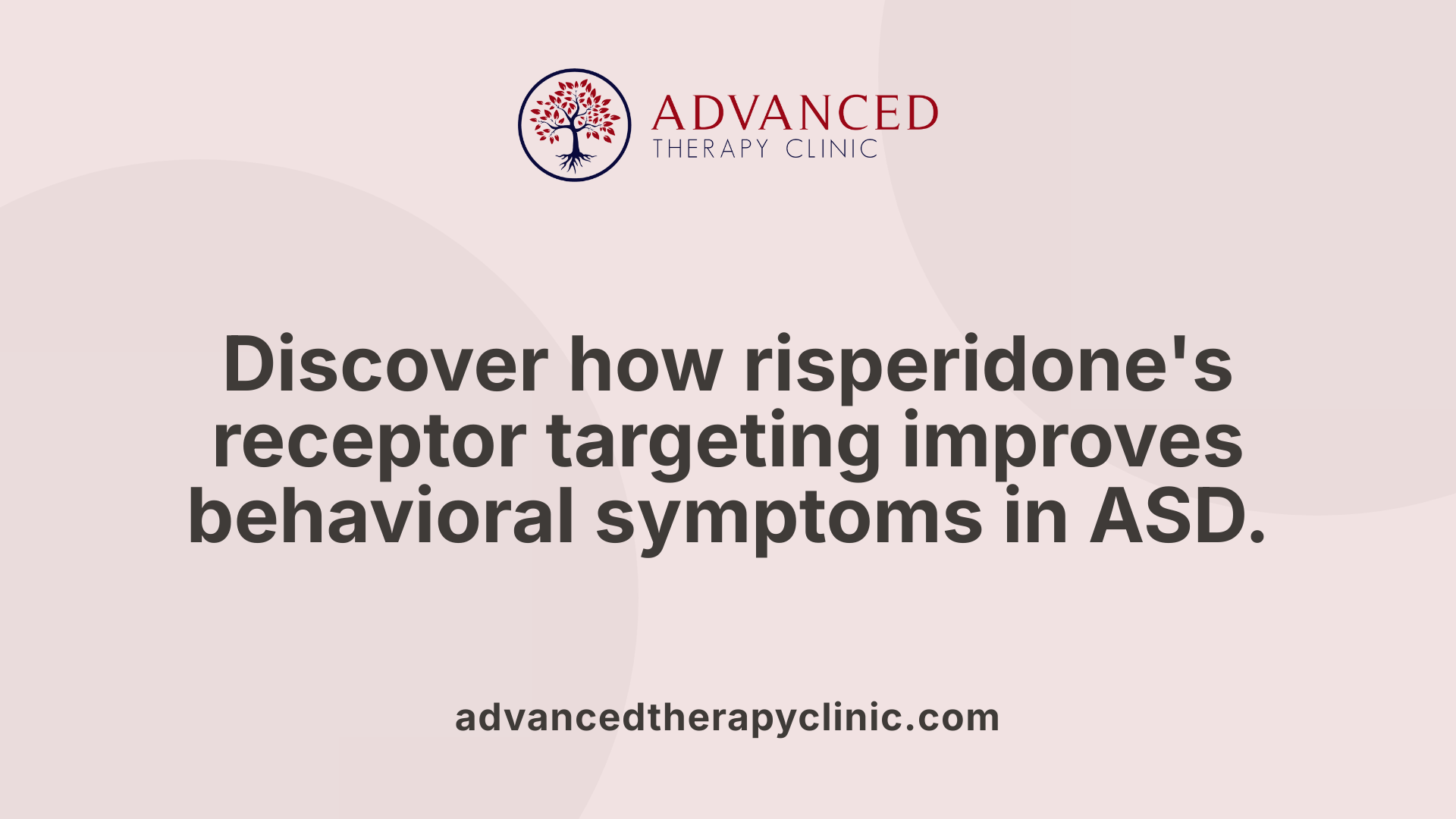Risperidone for Autism


Understanding Pharmacological Approaches to Autism Spectrum Disorder
Autism Spectrum Disorder (ASD) presents a complex array of behavioral and developmental challenges that often require multifaceted treatment approaches. While therapy-related fields such as Applied Behavior Analysis (ABA), speech therapy, and occupational therapy focus on improving skills and daily functioning, pharmacological treatments address behavioral symptoms to improve quality of life. Risperidone, a second-generation antipsychotic, stands as a prominent medication approved by the FDA specifically for treating irritability associated with autism. This article explores risperidone's role in managing ASD behavioral symptoms, its efficacy, safety profile, and how it fits within the broader landscape of autism interventions.
Comprehensive Overview of Therapy-Related Fields in Autism

What are the different types of therapy included under the umbrella term for therapy-related fields?
The umbrella term for therapy-related fields in autism includes a variety of specialized approaches designed to support individuals with ASD in multiple dimensions of functioning. Key therapies under this umbrella are:
- Applied Behavior Analysis (ABA): Focuses on behavioral modification to reinforce positive behaviors and reduce problematic ones.
- Speech Therapy: Aims to improve communication skills, including speech production, language comprehension, and social communication.
- Occupational Therapy: Supports development of daily living skills and sensory integration for better functioning in everyday environments.
- Physical Therapy: Addresses motor skills, coordination, and physical mobility challenges.
- Counseling and Psychological Therapy: Provides emotional support and helps manage anxiety, mood disorders, and social skills.
- Nutrition Therapy: Targets dietary management to improve health and address feeding issues.
Other complementary approaches include art therapy, music therapy, and respiratory therapy, depending on individual needs. These therapies collectively aim to enhance the quality of life, promote independence, and facilitate integration into academic and social settings.
Roles and goals of these therapies in autism treatment
Therapeutic interventions in autism focus on reducing core and associated symptoms to improve adaptive functioning. For example, ABA is often used to manage challenging behaviors, while speech therapy enhances communication abilities. Occupational and physical therapies help with sensory processing and motor development, respectively. Counseling addresses emotional regulation and social adaptation. The combined goals are to improve social interaction, communication, daily living skills, and overall behavioral outcomes. These therapies function as essential complements to medical treatments when behavioral symptoms are present but are distinct from pharmacological interventions such as risperidone, which targets specific behavioral symptoms rather than developmental progress.
Together, therapy-related fields form a comprehensive support system that addresses a broad range of needs in individuals with autism, supporting their development and engagement in everyday life.
Risperidone: Origin and FDA Approval for Autism

Development and Original Use of Risperidone
Risperidone is a second-generation, atypical antipsychotic initially developed to treat schizophrenia and other psychotic disorders. Known under the brand name Risperdal, its mechanism of action involves antagonism of dopamine D2 and serotonin 5-HT2A receptors. This pharmacological profile helps reduce symptoms related to psychosis and behavioral disturbances.
FDA Approval for Irritability in Autistic Disorder
In 2006, risperidone received approval from the U.S. Food and Drug Administration (FDA) specifically for treating irritability associated with autism spectrum disorder (ASD). This approval marked an important milestone, providing clinicians with a pharmacological option to address behavioral symptoms such as aggression, severe tantrums, and self-injurious behavior in individuals with ASD.
Age Range and Indications for Use
The FDA-approved indication covers children and adolescents aged 5 to 16 years diagnosed with autism. Risperidone is prescribed primarily to manage irritability but has also been effective in reducing hyperactivity, stereotypic behaviors, and inappropriate speech. While initially developed for psychiatric conditions, its use in autism is targeted at behavioral symptoms rather than core developmental features. This approval has contributed to its widespread use in pediatric populations with ASD to improve behavior and social functioning.
Mechanism of Action Behind Risperidone’s Efficacy in ASD

Pharmacological Class of Risperidone
Risperidone is classified as a second-generation, or atypical, antipsychotic. This class of medications is distinguished from first-generation antipsychotics by their reduced risk of certain neurological side effects and broader receptor activity.
Dopamine D2 and Serotonin 5-HT2A Receptor Antagonism
The primary mechanism through which risperidone exerts its effects is antagonism of dopamine D2 and serotonin 5-HT2A receptors. By blocking dopamine D2 receptors, risperidone helps reduce symptoms related to dopamine dysregulation, which may include irritability and aggression. Its simultaneous antagonism of serotonin 5-HT2A receptors modulates mood and cognition, contributing to improvements in social withdrawal and stereotypic behaviors.
How Receptor Antagonism Relates to Behavioral Symptom Improvement
The combined dopamine and serotonin receptor blockade helps balance neurotransmitter activity that underlies many behavioral symptoms seen in autism spectrum disorder (ASD). This pharmacological action appears to reduce hyperactivity, irritability, and repetitive behaviors commonly experienced by children and adolescents with ASD. By targeting these specific receptors, risperidone can calm disruptive behaviors and improve overall functioning, making it an effective option for symptomatic management in ASD.
Clinical Benefits of Risperidone in Managing Autism Behaviors

How does risperidone reduce irritability, hyperactivity, and stereotypic behaviors in autism?
Risperidone, an atypical antipsychotic, has demonstrated consistent ability to decrease irritability, hyperactivity, and stereotypic behaviors in children and adolescents with autism spectrum disorder (ASD). Its antagonism of dopamine D2 and serotonin 5-HT2A receptors likely contributes to calming severe behavioral symptoms such as aggression and impulsivity. This effect helps reduce common challenges faced by individuals with ASD like self-injury and aggressive outbursts.
What improvements have been observed in inappropriate speech and lethargy?
Beyond targeting core behavioral problems, risperidone also shows benefits in reducing inappropriate speech and lethargy in ASD patients. Meta-analyses combining results from multiple clinical trials reveal improvement in speech-related issues and increased engagement with social environments, helping children better interact with peers and caregivers.
What evidence supports risperidone's effectiveness in these behavioral domains?
A meta-analysis of 7 studies including 330 children and adolescents found that risperidone significantly decreased scores on the Aberrant Behavior Checklist (ABC) scale, indicating broad behavioral improvements across irritability, stereotypy, hyperactivity, inappropriate speech, and lethargy. Another meta-analysis reviewing 22 studies confirmed a large effect size (~1.1), which reflects a marked decline in problematic behaviors associated with ASD.
How does risperidone impact overall behavior and social function in ASD?
By alleviating irritability and hyperactivity symptoms, risperidone positively influences overall behavioral regulation and social functioning in children with ASD. These improvements can lead to better classroom performance and enhanced family interactions, supporting a more stable daily routine and improved quality of life.
| Behavioral Symptom | Effect of Risperidone | Source/Detail |
|---|---|---|
| Irritability | Significant reduction | FDA-approved indication since 2006 |
| Hyperactivity | Noticeable decrease | Shown in multiple clinical trials and meta-analyses |
| Stereotypic behaviors | Reduced repetitive movements | Included in ABC scale improvements |
| Inappropriate speech | Improved communication engagement | Meta-analysis outcomes |
| Lethargy | Decrease in social withdrawal and lethargy | Supported by Aberrant Behavior Checklist findings |
| Overall social function | Enhanced social interactions and behavior regulation | Clinical observations and study reports |
This evidence underscores risperidone’s role as an effective pharmacological option for managing several challenging behavioral symptoms of ASD when used alongside comprehensive treatment plans.
Efficacy Evidence: Meta-Analyses and Research Data
What does the meta-analysis reveal about risperidone's effects in autism?
Multiple meta-analyses have consistently shown risperidone's effectiveness in reducing a broad range of behavioral symptoms in children and adolescents with Autism Spectrum Disorder (ASD). A notable analysis combining data from 7 studies involving 330 youths demonstrated significant improvements on the Aberrant Behavior Checklist (ABC) scale. This improvement encompassed reductions in irritability, hyperactivity, stereotypic behaviors, inappropriate speech, and lethargy.
What are the effect size and statistical significance?
Across 22 studies, risperidone exhibited a large effect size of approximately 1.1, indicating a robust magnitude of change—roughly equivalent to one standard deviation improvement—in problematic behaviors commonly associated with ASD. These findings confirm that the medication's impact is both statistically significant and clinically meaningful.
How do these findings influence clinical practice?
Given risperidone's strong efficacy in ameliorating irritability and other behavioral difficulties, clinical guidelines often position it as a first-line pharmacological option specifically for irritability in ASD. However, due to known side effects such as weight gain and potential metabolic disturbances, treatment must include ongoing monitoring. The evidence supports risperidone's role in improving overall behavior and social functioning, complementing but not replacing behavioral and psychosocial interventions.
These data underscore the medication's importance in stabilizing behavioral symptoms that impede daily functioning and quality of life for individuals with ASD, provided its use is carefully managed with consideration of potential risks.
Safety Profile and Common Side Effects Associated with Risperidone

Weight gain and metabolic changes
Risperidone treatment in children and adolescents with autism spectrum disorder (ASD) is frequently associated with significant weight gain and increases in waist circumference. This weight gain can elevate risks for metabolic syndrome, diabetes, and cardiovascular problems. Consequently, regular monitoring of weight, body mass index, waist size, and relevant metabolic parameters such as blood glucose and lipids is strongly recommended during therapy to detect and manage these potential complications early.
Neurological symptoms like tremors and extrapyramidal effects
Some patients using risperidone may experience neurological side effects, including tremors and other extrapyramidal symptoms (EPS). These motor disturbances, while generally less common than metabolic issues, require clinical attention and follow-up. Monitoring for involuntary movements and other signs helps to balance therapeutic benefits with neurologic safety.
Other side effects such as sedation, appetite changes, infections
Additional adverse effects reported during risperidone treatment include sedation, which may affect daily functioning, increased appetite contributing to weight gain, and increased susceptibility to upper respiratory tract infections. Periodic clinical assessment can help to identify these side effects early and allow modification of treatment if necessary.
Monitoring protocols to detect adverse effects
Standardized monitoring protocols for patients on risperidone include baseline and ongoing evaluations of weight, waist circumference, blood sugar levels, lipid profiles, and prolactin levels. Neurological assessments to evaluate for EPS and tardive dyskinesia symptoms should also be routinely conducted. This comprehensive monitoring approach ensures early recognition of side effects and promotes safer long-term use of risperidone in managing behavioral symptoms of ASD.
Risks and Management Strategies for Long-Term Risperidone Therapy
What are the risks of discontinuing risperidone treatment?
Discontinuing risperidone in individuals with autism spectrum disorder (ASD) has been associated with a relapse in symptom severity. This highlights the importance of continuation in managing behavioral symptoms effectively over time.
What hormonal side effects are associated with risperidone?
Risperidone can cause elevation of prolactin levels, leading to hormonal disturbances such as gynecomastia and other related conditions. These side effects warrant monitoring, as they can impact long-term health and quality of life.
What are the risks related to movement disorders?
Long-term use of risperidone carries a risk of extrapyramidal symptoms, including tremors and tardive dyskinesia—a neurological disorder characterized by repetitive, involuntary facial movements. Higher dosages and prolonged therapy increase this risk, making vigilant assessment essential.
Why are baseline and periodic assessments critical during risperidone therapy?
Regular monitoring before and during treatment is vital to detect and manage adverse effects promptly. Baseline tests typically include evaluations of weight, blood sugar levels, lipid profiles, prolactin levels, and neurological function. Periodic reassessments help ensure any emerging side effects or metabolic changes are addressed early.
Management strategies summary
| Risk Factor | Description | Monitoring Approach |
|---|---|---|
| Symptom relapse | Worsening behaviors after stopping medication | Careful tapering and continued evaluation |
| Hormonal side effects | Prolactin elevation leading to gynecomastia and hormonal disruption | Regular hormonal assays and clinical exams |
| Movement disorders | Tremors, tardive dyskinesia from prolonged use | Neurological exams and dose adjustments |
| Metabolic and weight changes | Weight gain and metabolic syndrome | Weight, glucose, and lipid monitoring |
Maintaining a thorough monitoring protocol and weighing risks versus benefits ensures safer long-term use of risperidone in managing behavioral symptoms of ASD.
Integrating Risperidone with Non-Pharmacological Therapies
What is the role of risperidone as complementary to therapies?
Risperidone primarily addresses behavioral symptoms in autism spectrum disorder (ASD), helping to reduce irritability, aggression, hyperactivity, and stereotypic behaviors. While effective in improving these challenging behaviors, risperidone does not replace therapeutic interventions such as Applied Behavior Analysis (ABA), speech therapy, or occupational therapy. Instead, it serves as a complementary tool, managing symptoms that might otherwise limit a child's ability to participate fully in non-pharmacological treatments.
How is pharmacological treatment distinct from therapy-related fields?
It is important to recognize that risperidone is a pharmacological agent, targeting neurochemical imbalances through dopamine D2 and serotonin 5-HT2A receptor antagonism. Therapy modalities like ABA, speech therapy, and social skills training focus on skill-building and behavioral modification through structured learning and interaction. The medication manages symptoms that interfere with these interventions but does not teach or replace fundamental skills development.
When is risperidone used in crisis situations and how does it transition to behavioral interventions?
In situations of severe behavioral crises, risperidone can be used temporarily to stabilize disruptive behaviors and impulsivity. This stabilization often allows children to better engage in targeted behavioral and psychosocial interventions. The goal is typically to use the medication as a short-term measure while intensifying behavioral therapy efforts for long-term management. Gradually, with improved behavioral control, pharmacological reliance may decrease as therapeutic gains are consolidated.
Overall, combining risperidone with non-pharmacological therapies and comprehensive clinical oversight offers a balanced approach to managing behavioral challenges associated with ASD, ensuring that medication use is carefully monitored alongside supportive therapies.
Clinical Guidelines and Monitoring Recommendations
What baseline tests are recommended for patients starting risperidone?
Before initiating risperidone treatment in children and adolescents with autism spectrum disorder (ASD), baseline assessments should include measurements of weight, waist circumference, blood sugar levels, lipid profile, and prolactin levels. Additionally, neurological evaluations are important to detect any pre-existing movement disorders and to establish a reference point for monitoring potential extrapyramidal symptoms.
How should ongoing monitoring be conducted?
Regular monitoring is essential during risperidone therapy to identify and manage side effects early. This routine surveillance involves periodic weight checks to detect rapid gain, as well as blood tests for glucose and cholesterol to monitor metabolic health. Prolactin levels should also be evaluated regularly due to risks of hormonal disturbances such as gynecomastia. Neurological monitoring for tremors, tardive dyskinesia, and other movement disorders is advised throughout treatment.
How is treatment effectiveness balanced against side effect risks?
Clinicians must carefully weigh the benefits of risperidone in reducing irritability, aggression, and repetitive behaviors against the risks of adverse effects like weight gain and metabolic complications. Decisions should be individualized, with thorough discussions of potential outcomes and side effects with families. Monitoring protocols help to ensure early intervention if negative effects arise, maintaining the necessary balance for optimal therapeutic results.
What role does a multidisciplinary team play in treatment planning?
Managing severe behavioral symptoms in ASD benefits from a coordinated approach involving psychiatrists, pediatricians, neurologists, dietitians, and behavioral therapists. This team collaborates to integrate pharmacological treatment with psychosocial and behavioral interventions. Multidisciplinary planning ensures comprehensive care, addressing both symptom control and the overall well-being of the patient.
These clinical guidelines underpin safe and effective use of risperidone in ASD, promoting therapeutic gains while minimizing risks through vigilant monitoring and collaborative care.
Implications for Families and Care Providers
How should families and care providers weigh the risks and benefits of risperidone?
Families and care providers are encouraged to carefully evaluate the potential benefits of risperidone in reducing behavioral symptoms such as irritability, hyperactivity, and aggression against the risks of side effects, notably weight gain and metabolic changes. Understanding that the medication can significantly improve quality of life, while requiring ongoing monitoring, helps in making balanced decisions.
Why is informed consent and education important?
Informed consent is crucial so families appreciate both the therapeutic advantages and possible complications of risperidone treatment. Education on expected effects, potential side effects like sedation, tremors, or hormonal changes, and the need for regular health assessments empowers caregivers to participate actively in care and ensures transparency.
How can families support adherence and manage side effects?
Supporting adherence involves setting expectations about medication benefits and side effects. Families should be alert to signs of weight gain or metabolic issues and work closely with healthcare providers for baseline and follow-up monitoring. Prompt communication of adverse effects can help adjust the treatment plan or introduce interventions to mitigate side effects.
What is the role of coordination with therapy and educational supports?
While risperidone targets behavioral symptoms pharmacologically, it does not replace behavioral or speech therapies. Coordination between medical treatment and educational or psychosocial supports is essential. Multidisciplinary collaboration maximizes overall outcomes, combining medication benefits with therapy to address core developmental needs and social functioning.
Current Trends in Antipsychotic Use Among Individuals with Autism
How many individuals with autism are prescribed antipsychotic medications?
Antipsychotic medications are commonly used in managing behavioral symptoms in autism spectrum disorder (ASD). Approximately one in five to six youth with autism and about 43% of adults with ASD have been prescribed antipsychotics. This widespread use reflects the challenges clinicians face in controlling severe behaviors such as irritability, aggression, and hyperactivity in this population.
What are the patterns of risperidone use in children and adults with autism?
Risperidone, also known by the brand name Risperdal, is the most frequently prescribed antipsychotic for ASD-related behavioral issues, especially in children. Approved by the FDA in 2006 for treating irritability in children aged 5 to 16 with autism, risperidone’s usage has increased significantly in this group. While its use is well-established in children and adolescents, risperidone is also prescribed off-label in adults for managing impulsive and aggressive behaviors associated with autism and related disorders.
What factors influence medication choice and usage in ASD?
The decision to use risperidone largely depends on symptom severity, such as pronounced irritability, aggression, or self-injurious behavior. Clinicians weigh the benefits of symptom reduction against the risk of side effects like rapid weight gain, metabolic disturbances, and neurological side effects. Regular monitoring of metabolic parameters, weight, and neurological health is standard practice to manage these risks. Additionally, the availability of alternative therapies, patient age, and individual response influence treatment protocols.
How has research influenced treatment protocols involving risperidone in ASD?
Extensive research, including meta-analyses of multiple clinical trials, confirms risperidone’s efficacy in improving behavioral symptoms such as irritability, hyperactivity, and repetitive behaviors in children and adolescents with ASD. This evidence has supported its designation as a first-line pharmacological treatment for irritability in ASD. Meanwhile, research continues to emphasize the importance of combining pharmacotherapy with behavioral and psychosocial interventions and using multidisciplinary approaches to optimize outcomes.
| Aspect | Details | Implications |
|---|---|---|
| Prevalence | 20% of youth, 43% of adults with ASD prescribed antipsychotics | High usage highlighting treatment challenges |
| Risperidone FDA approval | Approved since 2006 for irritability in children 5-16 years | Increased adoption in pediatric ASD treatment |
| Side effect considerations | Weight gain, metabolic risks, neurological effects | Requires ongoing monitoring and risk management |
| Treatment approach evolution | Integration with behavioral therapies recommended | Holistic care improves long-term outcomes |
Future Directions and Research Needs in Pharmacological ASD Management
What are the limitations of current evidence on risperidone use in ASD?
While risperidone has a well-established effectiveness in reducing irritability and other behavioral symptoms in children and adolescents with ASD, current evidence highlights several limitations. Most studies focus on short- to medium-term outcomes (up to 8 weeks to a few months), with less robust data on long-term efficacy and safety. Although long-term use improves symptoms, it is also associated with metabolic side effects such as significant weight gain and increased waist circumference, raising concerns about health risks over extended periods. Additionally, there is limited evidence guiding optimal dosing strategies and duration for balancing benefits and risks.
What novel agents and combination strategies are being explored?
Research is advancing toward developing newer pharmacological agents that might offer improved safety profiles and efficacy. Investigations are ongoing into drugs targeting different neurotransmitter pathways than those affected by risperidone, aiming to mitigate behavioral symptoms without introducing metabolic complications. Moreover, combination approaches that integrate pharmacotherapy with behavioral or psychosocial interventions are gaining attention to enhance overall treatment outcomes. These combinations may allow for lower medication doses while maximizing behavioral improvements.
Why is personalized medicine important for ASD treatment?
ASD is a highly heterogeneous disorder, and response to risperidone varies among individuals. Personalized medicine models that utilize genetic, metabolic, and behavioral biomarkers may help predict which patients are most likely to benefit from risperidone or alternative treatments while minimizing adverse effects. Tailoring medication regimens to individual profiles could enhance therapeutic efficacy and safety and reduce unnecessary exposure to side effects.
What ongoing trials and emerging data are relevant?
Multiple ongoing trials continue to explore the efficacy and safety of risperidone and other antipsychotics in diverse ASD populations, including studies focusing on long-term outcomes. Emerging data are examining new pharmacological targets and innovative treatment combinations. There is also increasing emphasis on integrating pharmacological data with behavioral therapy to build comprehensive care models. As these studies mature, they are expected to refine clinical guidelines and foster more nuanced treatment plans for managing behavioral symptoms in ASD.
By addressing these research gaps and pursuing well-designed clinical studies, the future pharmacological management of ASD may become more effective, safer, and personalized, ultimately improving quality of life for individuals affected by autism spectrum disorder.
Balancing Benefits and Risks in Autism Behavioral Management
Risperidone remains a critical tool in the pharmacological management of behavioral symptoms associated with Autism Spectrum Disorder. Its demonstrated efficacy in reducing irritability, aggression, and repetitive behaviors offers meaningful improvement in quality of life for many individuals and families. However, its use requires careful consideration of side effects, particularly metabolic and neurological risks, necessitating rigorous monitoring and a multidisciplinary approach. Importantly, risperidone complements rather than replaces comprehensive therapy-related interventions, underscoring the need for integrated, individualized treatment plans. As research progresses, ongoing evaluation will refine optimal strategies to safely harness pharmacotherapy benefits alongside behavioral and psychosocial supports.
References
Recent articles

Expressive Speech Delay 2-Year-Old
Understanding and Addressing Expressive Speech Delay in Toddlers

How Speech Recognition Works
Unlocking the Power of Speech Recognition in Therapy and Healthcare

Autism and Head Size
Understanding the Complex Relationship Between Autism and Head Size

Occupational Therapy in Autism
Enhancing Independence and Quality of Life Through Occupational Therapy in Autism

Do Autistic People Understand Sarcasm?
Navigating the Nuances: Understanding Sarcasm and Social Communication in Autism

Autism Routines
Crafting Effective Daily Structures for Children with Autism

